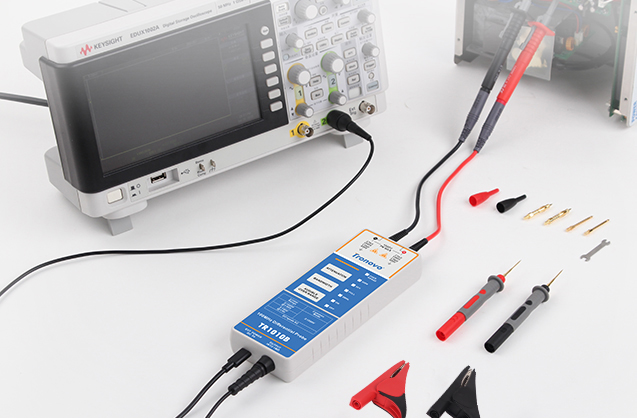TR1010C high-voltage differential probes are suitable for all major oscilloscopes in the market, converting a floating signal to a low-voltage signal at the ground level, making it safe and easy to display any geographic-level oscilloscope. The probe can be used at frequencies up to 100MHz for voltage signals up to 3000V and has high common-mode rejection, making it an excellent choice for non-georeferenced, floating, or isolated measurements. Angstrom oscilloscope differential probes are ideal for power testing, switching power supplies, inverters, motor drive control, switching power supply development, maintenance and evaluation.
Features:
• Safe floating measurements
• No damage to the oscilloscope and device under test
• Strong anti-interference ability
• Audible and visual alarm function
• 5MHz bandwidth limit function selection
• Good common-mode noise rejection
 |
Safe Floating MeasurementsDifferential probes can be used to directly measure multi-channel non-common ground circuits without fear of damaging the device or measurement system under test, and the oscilloscope is isolated from the signal under test with high impedance and no risk of electric shock. |
The probe is safe to useA common but risky practice is to disconnect the oscilloscope's power grounding wire, as floating measurements can generate dangerous voltages on the oscilloscope, and the user touching the instrument will be the shortest path to ground and be electrocuted. |
 |
 |
CMRR performance upgradesCommon-mode rejection ratio (CMRR) refers to the ability of a differential probe to suppress any signal shared by two test points in a differential measurement. If the CMRR index of the differential probe is not good, the common-mode voltage will be added to the differential voltage, causing measurement errors. |
The oscilloscope interface is compatible for useThe oscilloscope does not automatically recognize the attenuation ratio of other brands of probes, and the probe attenuation ratio needs to be manually set on the oscilloscope to prevent deviations in the measured values |
 |
 |
Rise time testThe DS6104 outputs a fast-edge signal with a frequency of 1MHz, amplitude of 2Vpp, and a rise time of 600ps to the input of the differential probe via a cable. |
Output noise testShort the input of the probe and connect the output to the oscilloscope. Set the attenuation step of oscilloscope channel 1 to 5 mV/div, the scan time to 50 nS/div, and the input impedance to 1 MΩ. |
 |
| Model | TR1010C |
| Bandwidth (-3dB) | 100MHz |
| Rise time | ≤3.5ns |
| Precision | ±2% |
| Range selection (attenuation ratio) | 100X/1000X |
| Maximum differential measurement voltage | 100X:±300V DC+ Peak AC 1000X:±3000V DC+ Peak AC |
| Common-mode voltage | ±3000V DC + Peak AC |
| Maximum input voltage to ground | 600VCATⅢ 1000VCATⅡ Vrms |
| Input impedance | Single-ended to ground: 5MΩ±1% Between the two inputs:10MΩ±1% |
| Input capacitance | Single-ended to ground: <4pF Between the two inputs:<2pF |
| CMRR | DC: >80dB 100KHz: >60dB 1MHz: >50dB 3.2MHz: >30dB 50MHz: >26dB |
| Noise level | 100X: <100mVrms 1000V: <600mVrms |
| Overload indication voltage threshold | 100X: ≥300V 1000X: ≥3000V |
| Bandwidth limit (5MHz) long | ≥-3dB@5MHz |
| Overload indicator | have(Red light) |
| 过载报警声 | have(Optionally closed) |
| Auto-save function | have |
| Offset adjustable function | have(Adjust in test mode) |
| Terminal load requirements | ≥100kΩ |
| Power supply | USB 5V/1A adapter |
| Safety meets standards | EN61010-1:2010 |
| EMC is compliant | EN61326-1:2013 EN61000-3-3:2013 |
There are currently no application cases available
There are currently no films available